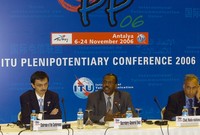 I should have expected the International Telecommunications Union (ITU)
to be involved in this:
I should have expected the International Telecommunications Union (ITU)
to be involved in this:
Another document came out last week that ties this all together. It’s from the ITU, and it’s called “Trends in Telecommunication Reform 2007: The Road to Next-Generation Networks (NGN).”This takes us back to the bad old days when national telephone companies sold you data service by the byte, through their preferred protocol, X.25. The advantage of circuit switching was supposed to be fully provisioned copper wires or other resources all the way through between two parties. The disadvantages were that you sometimes couldn’t get a connection and the high price, which got even higher between countries. It seems the telcos have settled on MPLS as their modern equivalent of X.25.The ITU defines “NGN” as a network that provides quality-of-service-enabled transport technologies. The idea is that packet transport will be “enriched with Multi Protocol Label Switching (MPLS) to ensure Quality of Service (QoS).”
Translation, as far as I can tell: packet transport becomes the same as circuit-switched transport. Prioritization is controlled; it’s a network optimized on billing.
— Tying things together, by Susan Crawford, Susan Crawford blog, Mon 10 Sep 2007 08:05 PM ED
-jsq